Venture in Prince William Sound
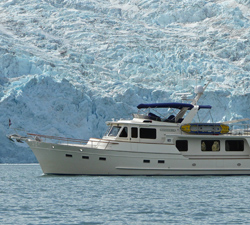
 Story & Photos by Tony Fleming
Story & Photos by Tony Fleming
Vast, magnificent and remote, Prince William Sound offers the ultimate adventure for cruisers on North America’s West Coast.
Few cruising boats visit beautiful and remote Prince William Sound. Some 2,800 square miles in area and situated at the very northern tip of the Gulf of Alaska, from which it is separated by a series of major barrier islands, this inland sea has a coastline equal to that of Oregon and California combined. Within its boundaries lie the towns of Cordova, Valdez and Whittier ̶ as well as the native American villages of Chenega and Tatitlek.
To reach it, any boat too large to be put on a trailer and towed for hundreds of miles through mountainous terrain must be placed on a barge or brave a 500-mile transit across the open and often tempestuous waters of the Gulf of Alaska.
The main channel into Prince William Sound is Hinchinbrook Entrance where, driven by a tidal range as great as 18’, the volume of water streaming through at every turn of the tide is enormous, and the Coast Pilot warns of dangerous conditions when an ebbing tide meets a southerly gale. Our timing was good but, even so, currents swirled around us, producing weird upwellings and waves that danced a strange fandango.
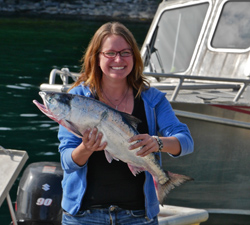 Inside the sound, our first port of call was the small town of Cordova, famous for its Copper River salmon. The fishing season was in full swing and the docks were largely empty as fishing boats were taking advantage of one of the carefully controlled “openings.” As is common in the Pacific Northwest, we were allocated a berth vacated by a working boat.
Inside the sound, our first port of call was the small town of Cordova, famous for its Copper River salmon. The fishing season was in full swing and the docks were largely empty as fishing boats were taking advantage of one of the carefully controlled “openings.” As is common in the Pacific Northwest, we were allocated a berth vacated by a working boat.
We had arrived here from Vancouver Island aboard Venture, a Fleming 65 with almost 40,000 miles under her keel. On board, apart from Capt. Chris Conklin and myself, were Christine and deckhand Kaylin Coleman who was working towards her captain’s licence. We were joined in Cordova by Brian Kell of Grand Yachts, who represents Fleming Yachts in Vancouver.
Disastrous History
Prince William Sound suffered two major disasters 25 years apart: both, ironically, on Good Friday. The first, in 1964, was a 9.2 earthquake with its epicentre under the sound that caused massive destruction in Anchorage. Tsunamis resulting from the quake severely damaged the towns of Cordova and Whittier and completely destroyed Valdez along with the traditional village of Chenega.
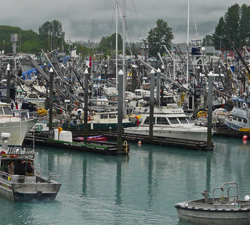 The second disaster, in 1979, was the oil spill from the tanker Exxon Valdez which devastated the sound and its surrounding waters. With the National Transportation Safety Board report in hand, we could not resist visiting the site of the accident and, in poor visibility, followed the same 180-degree course line taken by the doomed tanker, even to the extent of running directly over Bligh Reef. But Venture draws only five feet, compared to the ill-fated tanker’s 65′ so there was no risk. The report listed many factors which contributed to the accident but, like other tankers before her, the Exxon Valdez had been forced to divert from her normal course by ice flowing from the Columbia Glacier.
The second disaster, in 1979, was the oil spill from the tanker Exxon Valdez which devastated the sound and its surrounding waters. With the National Transportation Safety Board report in hand, we could not resist visiting the site of the accident and, in poor visibility, followed the same 180-degree course line taken by the doomed tanker, even to the extent of running directly over Bligh Reef. But Venture draws only five feet, compared to the ill-fated tanker’s 65′ so there was no risk. The report listed many factors which contributed to the accident but, like other tankers before her, the Exxon Valdez had been forced to divert from her normal course by ice flowing from the Columbia Glacier.
Since 1980 this glacier has retreated 19 kilometres and lost half its thickness. Although it continues to retreat at a rapid rate, it no longer spews ice into the shipping lanes in quantities sufficient to disrupt shipping. We encountered floating ice as soon as we entered Columbia Bay where we turned aside and anchored at the top of Header Bay, passing numerous icebergs stranded in shallow water.
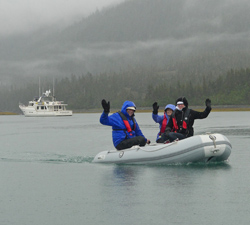 Frigid rain was falling as we launched both tenders and picked our way between floating and grounded chunks of ice the size of houses. While alongside a floe, we were startled by a sudden bang – as loud as a signal gun. Large slabs of ice tumbled into the water, sank and then rebounded with water sluicing off them only inches away as a nearby floe disintegrated. It was a scary and timely reminder to keep a safe distance from these beautiful but treacherous ice sculptures.
Frigid rain was falling as we launched both tenders and picked our way between floating and grounded chunks of ice the size of houses. While alongside a floe, we were startled by a sudden bang – as loud as a signal gun. Large slabs of ice tumbled into the water, sank and then rebounded with water sluicing off them only inches away as a nearby floe disintegrated. It was a scary and timely reminder to keep a safe distance from these beautiful but treacherous ice sculptures.
On the 4th of July we passed through Valdez Narrows between Entrance Point and Entrance Island to the marina at Valdez. This was the first town in Alaska we had visited which has a road connecting it with Anchorage nearly 500 kilometres away. I assume the road is often impassable during the winter because normal annual snowfall here is between 750 and 1,250 centimetres, with a record of 1,415 centimetres set during the winter of 1989-90. The port was packed with commercial fishing boats awaiting the next opening and we had to wait outside the harbour until they could find a berth for us. Brian left us here and we were joined by Steve d’Antonio, technical editor of PassageMaker magazine and technical consultant to the marine industry.
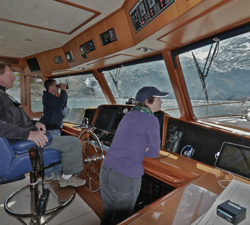 Close to the Ice
Close to the Ice
Continuing our journey, we found ourselves in dense fog as soon as we left the harbour. Shadowy forms of fishboats materialized out of the mist as we navigated cautiously, using radar to guide our way. Visibility improved once we passed through Valdez Narrows. We turned into Unakwik Inlet and pushed aside ice to reach the face of Meares Glacier. As is often the case, the weather improved as we approached the icy face, passing many otters and seals on the ice floes.
Prince William Sound boasts a total of 150 glaciers, of which 17 are tidewater – meaning that they are afloat – and the majority are located in the western part of the sound. The Harriman Expedition in 1899 named many of the glaciers in this area after American colleges. We saw both Harvard and Yale glaciers but the accumulation of ice made it impractical to proceed to within six miles of their face. Water depths in the sound frequently exceed 1,500′ but they reduce abruptly at the remains of terminal moraines left by glaciers before they retreat.
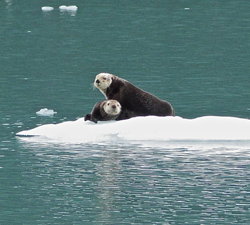 It is even possible to go aground at these spots and care has to be taken to watch chart and depth sounder. Many floes carried chunks of rock and we saved a handful from a watery grave to keep as souvenirs. Countless waterfalls tumbled in great profusion down precipitous slopes. We reached our farthest north at 61 degrees 10.3 minutes and anchored for the night in Heney Bight.
It is even possible to go aground at these spots and care has to be taken to watch chart and depth sounder. Many floes carried chunks of rock and we saved a handful from a watery grave to keep as souvenirs. Countless waterfalls tumbled in great profusion down precipitous slopes. We reached our farthest north at 61 degrees 10.3 minutes and anchored for the night in Heney Bight.
We passed close to the epicentre of the 1964 earthquake which had caused the whole of the sound to tilt – with the southern portion, at the west end of Montague Island, being raised an incredible 31.5′ and the northern portion, around College Fjord, sinking 8′. The encroachment of the sea upon the land killed the trees creating what are referred to as “ghost forests.” Along the shore, bleached skeletons of dead trees bore testament to the cataclysmic upheaval.
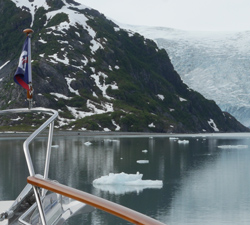 Our cruising now took on a more leisurely pace – we moved only a few miles per day as we explored the features of this magical area. We anchored in Hobo Bay off College Fjord where Chris and Kaylin stayed on board to carry out boat maintenance while Christine, Steve and myself went ashore in the small tender to search for the remains of a derelict mine, reputed to be accessible along an easy half-mile trail.
Our cruising now took on a more leisurely pace – we moved only a few miles per day as we explored the features of this magical area. We anchored in Hobo Bay off College Fjord where Chris and Kaylin stayed on board to carry out boat maintenance while Christine, Steve and myself went ashore in the small tender to search for the remains of a derelict mine, reputed to be accessible along an easy half-mile trail.
It is not until you attempt to hike ashore that you appreciate the achievements of the early prospectors and pioneers who surveyed this terrain. What appear to be meadows turn out to be boggy muskeg into which you sink calf-deep. Portions of the route were steep and required bushwhacking through tangled undergrowth. At one point we had to ford a mountain stream over slippery rocks; mosquitoes and other bugs required the use of head nets. Although we came across occasional signs of a trail and footprints we never found the mine.
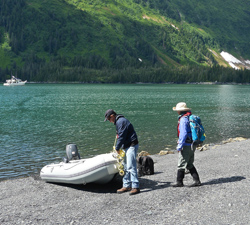
Waterfalls
Our next destination was Blackstone Glacier at the top of Blackstone Inlet – nicknamed “Deathtrap” because of its propensity to drop large chunks of ice down to the water from a steep slope, out of view, above its vertical face. This area was exceptionally beautiful with a couple of magnificent waterfalls. A gaggle of kayakers were reduced to the size of insects by the immensity of their surroundings.
It was time for another change of crew – this time at the town of Whittier. Located at head of Passage Canal, the town originated as a military dock and fuel depot in 1942.
In 1943, it was connected to Anchorage by a rail spur which required the construction of two tunnels – one of which was four kilometres long under Maynard Mountain. As recently as June 2000 a road was built to share this tunnel with the train and, for the first time, it was possible to drive to Whittier from Anchorage.
The small harbour was mostly filled with much smaller fishing boats than we had seen in both Cordova and Valdez. Most of these were trailerable and there was a continual flow of boats shuttling in and out of the narrow harbour entrance. Dock space was limited and Venture was tied up to a floating breakwater with no direct access to shore. We refueled here, taking on our first fuel since leaving Juneau.
From Whittier we continued south, visiting Deep Bay and Mink Island before reaching Eshamy Bay Lodge run by Duke Marolf and Pamela Eiting. Duke checked his gillnets and returned with a boatload of salmon. He sold most to a pickup boat waiting in the bay but generously presented us with two fillets which Pamela cooked for us. The lodge is attractively situated among the trees and accessible by boat or float plane from Whittier. It has limited but comfortable accommodations and we enjoyed a convivial evening with our generous hosts and other visiting boat owners, one of whom gave us shrimp he had caught that day.
We spent the next evening in Barnes Cove in Drier Bay on Knight Island. Overlooked by tall peaks, this was one of the most beautiful anchorages we had visited in the sound. We made a couple of expeditions ashore and climbed a knoll overlooking the bay where, below us in beautiful weather, Venture floated on gin-clear water the colour of jade.
Whales!
A couple of days later, while under way in Knight Island Passage, we overheard a radio call saying that there were super pods of whales, orcas and humpbacks, off Point Helen towards which, by good fortune, we were already heading. The caller said he had not seen such numbers for 10 years!
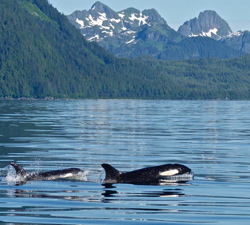 Through binoculars we could see tall fins and blows all across the horizon ahead of us over a calm and glassy sea. We arrived at the spot within 40 minutes and spent the next hour surrounded by these huge animals who seemed unfazed by our presence. It was a magical experience. We moved slowly and took care not to approach too closely. We continued on to isolated Needle Rock where many Steller sea lions were hauled out on the craggy rocks.
Through binoculars we could see tall fins and blows all across the horizon ahead of us over a calm and glassy sea. We arrived at the spot within 40 minutes and spent the next hour surrounded by these huge animals who seemed unfazed by our presence. It was a magical experience. We moved slowly and took care not to approach too closely. We continued on to isolated Needle Rock where many Steller sea lions were hauled out on the craggy rocks.
Chenega Glacier was our last tidewater glacier. Here, countless numbers of harbour seals watched our progress warily as we pushed our way through ice until we were within a quarter-mile of the glacier face. The mighty river of ice cracked and groaned as we waited impatiently, cameras at the ready, hoping to see slabs of ice calving from the fissured face. Our patience was finally rewarded when icy pinnacles slid majestically into the water.
Although not actually within the sound, we decided to include a visit to Seward before heading back across the Gulf of Alaska. The town is situated at the head of Resurrection Bay. The cliffs on Barwell Island at the entrance to this inlet were the most dramatic we had seen during the entire trip. There were many more pleasure boats in Seward than we had seen at the towns we had visited within the sound. At 149 degrees 26.2 minutes W longitude, Seward was our farthest point west.
From here we made an overnight stop at Montague Island before heading directly across the Gulf of Alaska to Cape Spencer and Icy Strait – a straight shot of 392 miles that lasted 42 hours. We had spent 28 days cruising Prince William Sound but you could devote a lifetime exploring this unique and beautiful area without exhausting its potential.
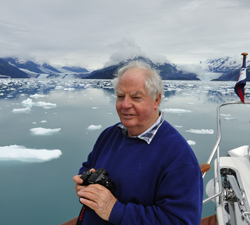 Trained in the aeronautical industry in England, Tony Fleming fell into the marine industry when, in 1961, he was invited to join American Marine in Hong Kong. He served as Engineering and Development Manager for the company, where he was responsible for much of the development of the Grand Banks. In 1985 he founded Fleming Yachts and, after 20 years, he retired from day-to-day company operations to devote time to using his boats. Since 2005, he has cruised more than 50,000 nautical miles aboard Venture which has served as a test bed for new ideas and equipment.
Trained in the aeronautical industry in England, Tony Fleming fell into the marine industry when, in 1961, he was invited to join American Marine in Hong Kong. He served as Engineering and Development Manager for the company, where he was responsible for much of the development of the Grand Banks. In 1985 he founded Fleming Yachts and, after 20 years, he retired from day-to-day company operations to devote time to using his boats. Since 2005, he has cruised more than 50,000 nautical miles aboard Venture which has served as a test bed for new ideas and equipment.
Cruising Resources
Cruising Guide to Prince William Sound by Jim and Nancy Lethcoe, 5th edition (Prince William Sound Books 2009)
Useful maps: National Geographic Prince William Sound – West and Prince William Sound – East.
Photo 1: Against the ice: The Fleming 65 Venture is dwarfed by Blackstone Bay’s Beloit Glacier.
Photo 2: Salmon is king in these parts.
Photo 3: Venture in the harbour at Valdez, which was packed with commercial fishboats.
Photo 4: Isn’t this fun?! Exploring Header Bay in a chilly rain.
Photo 5: Venture’s crew approaches a glacier with care: the water often shallows abruptly at moraines and floes can calve large pieces unexpectedly.
Photo 6 and 9: Humpback whales, killer whales and sea otters are common sights in the sound.
Photo 7: Prince William Sound has 150 glaciers, including 17 tidewater glaciers like this.
Photo 8: At Hobo Bay, our search for a nearby derelict mine was frustrated by muskeg and rugged terrain.




























